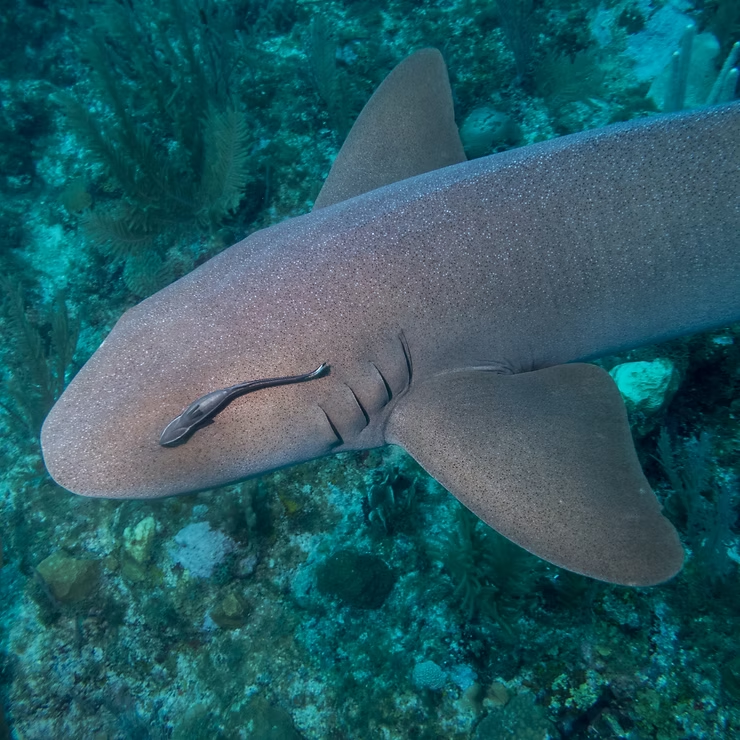Introduction
The nurse shark is a fascinating species found in coastal waters, coral reefs, mangrove forests, and seagrass beds. Known for their unique appearance and behaviors, nurse sharks are slow-moving, nocturnal predators that are generally docile towards humans.
Key Takeaways
- Bottom-dwelling sharks found in warm, shallow waters.
- Distinctive broad head, small eyes, and barbels on their snout.
- Nocturnal and spend most of the day resting.
- Slow swimmers relying on suction-like mouths to capture prey.
- Docile and generally harmless to humans.
Appearance
Nurse sharks have stout bodies with broad heads and rounded snouts. Their rough, sandpaper-like skin varies from light brown to dark gray, providing camouflage. Barbels on their lower jaw help locate prey, giving them a unique appearance. Despite their size, they are generally harmless to humans.
Habitat
Nurse sharks inhabit coastal waters, coral reefs, mangrove forests, and seagrass beds. They prefer sandy or rocky bottoms for resting and hiding. Found in the Atlantic Ocean, Caribbean Sea, and western Indian Ocean, they thrive in warm, shallow waters rich in food and shelter.
Diet
Nurse sharks are opportunistic feeders, consuming fish, crustaceans, mollusks, squid, and octopus. They hunt primarily at night using suction feeding and strong jaws to crush prey. Bottom-dwelling hunting allows them to access hidden or burrowed prey.
Behavior
Nocturnal Habits
Most active at night, nurse sharks rest in caves or under ledges during the day. They may also be active at dawn or dusk.
Social Interactions
Typically solitary, nurse sharks sometimes gather in small groups for feeding or mating. They communicate via body language and chemical signals.
Resting
As bottom dwellers, nurse sharks can pump water over their gills while stationary, allowing them to breathe and conserve energy.
Reproduction
Mating Behavior
Males nibble females’ pectoral fins during courtship. Internal fertilization occurs, and females carry eggs inside their bodies (ovoviviparous).
Gestation and Birth
Gestation lasts approximately six months. Females give birth to live pups, sometimes up to 40 at once. Pups are independent immediately after birth, receiving no further maternal care.
Interesting Facts
- Nurse sharks are slow swimmers but efficient hunters using smell and suction feeding.
- Bottom dwellers, often resting on the ocean floor to avoid predators.
- Despite myths, they are generally docile and non-aggressive toward humans.
- The name ‘nurse shark’ comes from ‘nusse,’ meaning ‘cat shark’ in Middle English.
- Conservation is important due to habitat loss and bycatch in fishing operations.
Conservation
Nurse sharks face threats from habitat destruction and bycatch. Protection of coral reefs, mangroves, and seagrass beds is vital. Fishing regulations and public awareness help conserve their populations.
Frequently Asked Questions
- Are nurse sharks dangerous? No, they are generally docile unless provoked.
- How big do they get? Up to 14 feet; average 7–9 feet.
- What do they eat? Fish, crustaceans, mollusks, and opportunistically scavenged food.
- Do they have teeth? Yes, multiple rows adapted for crushing prey.
- Where do they live? Warm, shallow waters of the western Atlantic, Caribbean, and Gulf of Mexico.
- Do nurse sharks sleep? They rest on the ocean floor but do not sleep like humans.
- Are they endangered? Listed as Least Concern but vulnerable to habitat destruction.
- Can they be pets? No, they are unsuitable due to size and care requirements.
Conclusion
Nurse sharks are gentle, bottom-dwelling predators that play a vital role in marine ecosystems. Their nocturnal habits, unique feeding methods, and docile nature make them fascinating creatures worthy of appreciation and protection.

